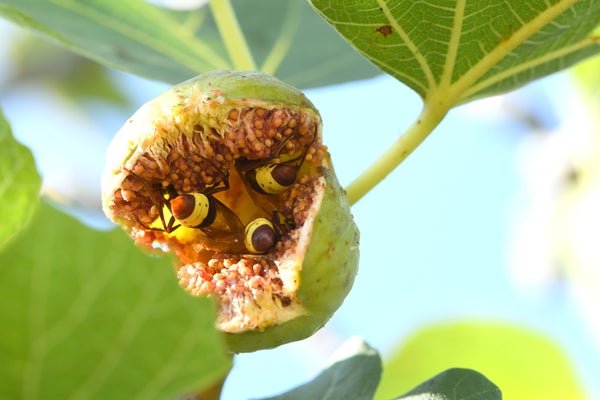October 24, 2024
3 min read
These Hornets Can Thrive on Just Alcohol without Getting Buzzed
Social wasps can hold their liquor

Three hornets feed on a ripe fig, which could provide naturally occurring ethanol.
An alcohol-only diet would throw most species for a loop, but new research suggests that hornets can live—apparently unimpaired—with an 80 percent ethanol sugar solution as their sole food source.
Fruit flies, tree shrews and many other animals naturally consume alcohol in fruits that ferment; this happens when yeast or certain bacteria are around to break down sugars in ripe fruit, creating small amounts of ethanol. Most animal species show signs of impairment or toxicity after consuming this substance at concentrations above 4 percent. But animal nutrition researcher Sofia Bouchebti, now at Ben-Gurion University of the Negev in Israel, suspected that hornets and wasps might tolerate alcohol better—or even use it as a food source. After all, these insects’ gut is known to host yeast that converts fruit sugar to alcohol. When hornets or wasps pollinate and feed, some of this yeast rubs off onto plants and their fruits—playing a key role in the fermentation process.
Bouchebti turned her attention to the hornet Vespa orientalis, a type of social wasp. In a study this week in Proceedings of the National Academy of Sciences USA, she and her colleagues at Tel Aviv University fed both hornets and honeybees sugar solutions containing 0 to 80 percent ethanol with a trackable carbon isotope. The researchers found that hornets’ exhaled breath contained up to 300 percent more labeled carbon than the honeybees’, suggesting the hornets’ bodies broke down the alcohol that much faster.
On supporting science journalism
If you’re enjoying this article, consider supporting our award-winning journalism by subscribing. By purchasing a subscription you are helping to ensure the future of impactful stories about the discoveries and ideas shaping our world today.
“There’s lots of energy in ethanol, and it’s a great metabolic fuel,” says study co-author and zoologist Eran Levin. The problem for humans and many other animals, of course, is that there are behavior and health consequences as the substance interacts with the brain and organs. But when provided with nest-building materials, the ethanol-fed hornets in the study completed construction tasks as efficiently as sugar-fed ones. When faced with an intruder, they did not delay sending “back off” signals. Moreover, hornets fed with 80 percent ethanol lived out their typical three-month-long lifespan; their honeybee counterparts died within 24 hours. Still, hornets showed no preference between sugar and ethanol when given a choice. “If ethanol is more nutritious and without bad effects, shouldn’t they want more? Maybe they can’t taste it,” Bouchebti suggests.
To distill the secret behind this metabolic mastery, study co-author and zoologist Dorothée Huchon led a hunt for genetic clues. She found that hornets possess multiple copies of the gene responsible for the enzyme that breaks down alcohol—an adaptation perhaps fueled by their relationship with yeast.
University of Rochester biologist James Fry, who was not involved in the new study, says it tells an “interesting evolutionary story.” But he cautions that the methods are too different from those of other studies to directly compare ethanol resistance between species.
Robert Dudley, an insect flight specialist at the University of California, Berkeley, notes that insects would never encounter such high ethanol values in nature. Bouchebti says the researchers “aimed to find a maximum limit, and we still didn’t find it.” Next up is examining gene expression during ethanol consumption and seeking patterns in this among animals known to be attracted to alcohol (some beetles and bats, for example). Dudley agrees: “A broader survey of social Hymenoptera and other insects is clearly called for,” he says.
